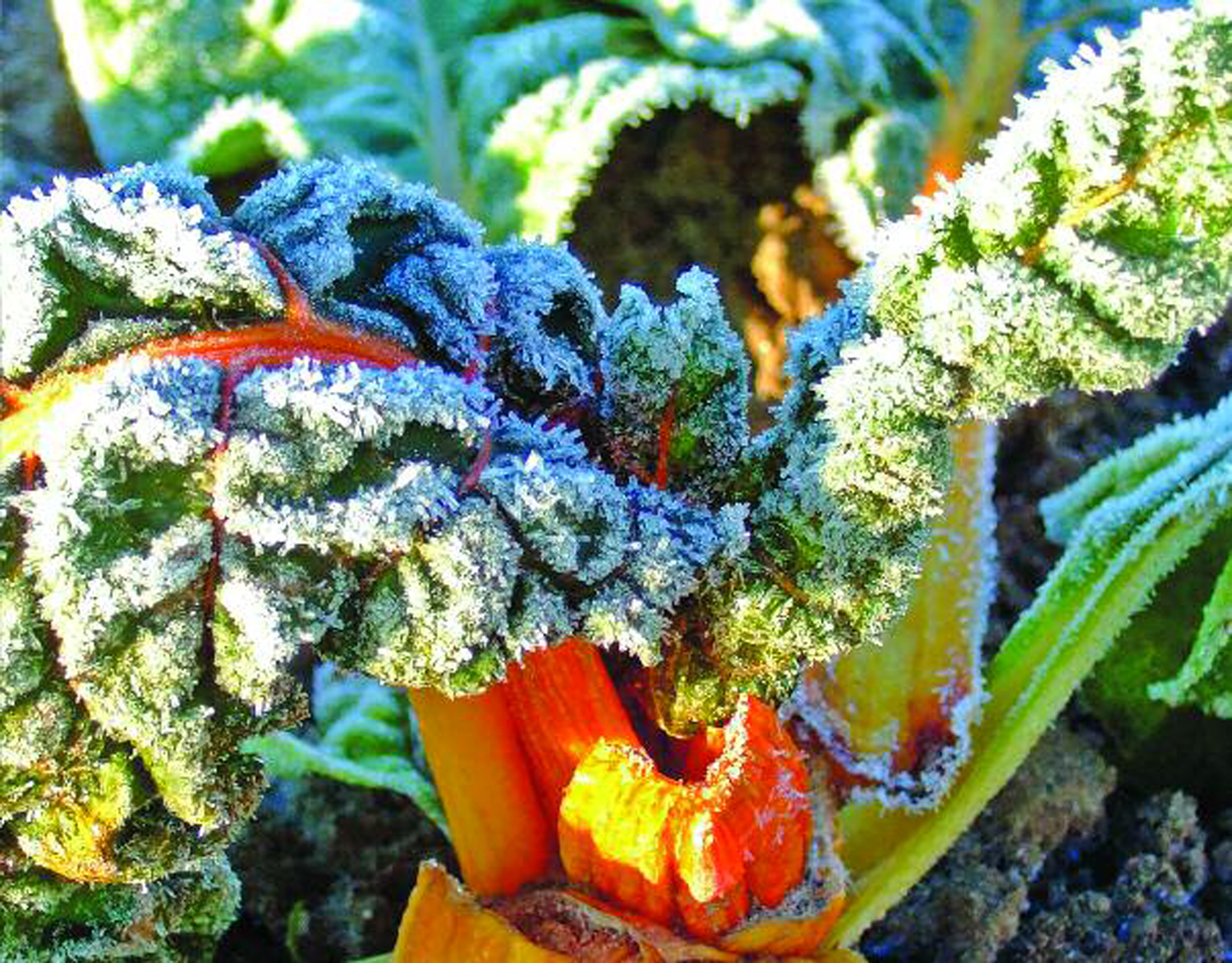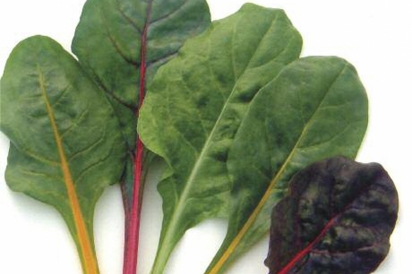All About Chard
Chard is known by many names. In England it was once known as white beet. But this was too easily confused with white-coloured beetroots. Nowadays it is called silver beet or sea kale beet. Alhough chard does not produce a useful edible root, it is very closely related to beets as is evidenced by its Latin name, Beta vulgaris cicla, (i.e., common beet cardoon).
For some reason, "chard" continues to be prefixed with "Swiss," even though the Swiss had nothing to do with the discovery, development or promotion of chard. Adding "Swiss" was just a way that seventeenth-century French seed catalogues differentiated chard from cardoons. Like chard, cardoons have broad stems and ribs. Beyond this similarity I cannot imagine how anyone could confuse the two vegetables. Cardoons are thistles with a dull grey/green colour, grow like celery stalks on steroids, are harvested after frost in the fall, and taste like tough, bitter artichokes. In the hands of an experienced gardener and a trained chef, cardoons can be absolutely delicious. Any beginning gardener or casual cook, on the other hand, can prepare delectable chard.
A thin-stemmed chard is called Perpetual Spinach. This name actually makes some sense since chard is closely related to spinach. But unlike spinach, which goes to seed after only a few weeks of growing, chard generally keeps producing all summer long.
To add even more confusion: in the north of France they discard the leaves and only use the stems, while in the south of France they discard the stems and only use the leaves, which are often used in tourte aux blettes, a sweet tart that is reminiscent of rhubarb pie. All over France the red and yellow forms of chard are referred to as Chilean (although they, of course, have nothing to do with Chile). But, in their favour, the French long ago discarded the inappropriate Swiss appendage.
Historical Record
Chard was likely first selected from Sicilian salt-marsh sea beets for a version with better tasting leaves rather than large edible roots. Aristotle mentioned red-stemmed chard in the fourth century BC. The Romans loved (and still love) its delicious minerally, earthy and nutty flavours. It made its way all around the Mediterranean and then East through Persia and China. Curiously it never seemed to appear in the Indian subcontinent, evidenced by there being no Sanskrit word for Chard.
Due to so much confusion with beets and cardoons, it is not really clear which varieties have been enjoyed through the centuries. But we can assume that it was very similar to the chard we enjoy today. Nearly all of the varieties presently available were popular in the eighteenth and early nineteenth centuries. This includes the red-, orange-, and yellow-stemmed varieties that one would be inclined to assume are modern hybrids.
One exception came in the 1990s when the late John Eaton, an amateur breeder in New Zealand, created a family of chards with exceptionally colourful petioles (stems). Johnny's Selected Seeds now carefully maintains and distributes these seeds as Bright Lights. (Notice how varying threads of colour cause the stems to appear to glow.) They are usually marketed to the public as Rainbow Chard.
Quality Growing
Chard is one of the easiest leafy green crops to grow. It does not go to seed like spinach. It does not turn bitter like lettuce and kale. It is not afflicted by flea beetles like arugula and mustard. And you only need to plant it once every summer. The more leaves you pick, the more leaves you get. Chard loves hot summer days as much as it loves frosty fall nights.
A single planting will normally continue producing fine quality leaves throughout the summer. To continue harvesting after the fall frosts have begun, it is helpful to have some more energetic younger plants started during a cool week in early August. (Chard does not germinate well when night-time temperatures rise above 20° C.) This late planting has a good chance to survive the winter for early spring chard. But the early crop will soon bolt (go to seed).
Not only is chard incredibly easy to grow, it is also incredibly nutritious—an excellent source of vitamins A, C and K, along with magnesium, potassium and iron. Plus, it has a pleasing, rich flavour that does not require added butter or oil, salt or sugar. Chard also has less oxalic acid than spinach, and notably less than beet leaves. (Oxalic acid, a bitter-tasting and mineral-inhibiting substance, can exacerbate a tendency towards kidney and gallbladder stones.)
I cannot say there is much difference between the varieties available from contemporary seed companies. They have all stood the test of time. The white varieties are somewhat more vigorous and productive. The coloured varieties are more appealing in both the garden and on the plate.
You can obtain earlier harvests by putting out bedding plants in mid-May. But if the plants have become root-bound, they never really recover. So I think you are better off just direct seeding three weeks before the last frost (early May). Put in about six seeds per foot about ½-inch deep in rows about one foot apart. They germinate quickly, but springtime birds do love the tender shoots. Since each "seed" is really a "fruit" containing several tiny seeds, it is difficult to know how many plants will actually become established.
When the plants are about 2 inches tall, thin them to 6 inches apart. Since the roots do not like being disturbed, cut (don't pull) out the excess plants (and use the tender leaves in early summer salads). While you are doing this, also cut out any weeds since chard does not compete well with them. When the plants are about 6 inches high you can start harvesting by twisting off the larger outer leaves.
Chard is a favourite food for some pests. Slugs and caterpillars might chew round holes in some leaves. Leaf miners lay their eggs inside the leaves so their larvae (which you can see inside the leaves) are protected from roving predator insects. Some leaves pick up a yellowing virus. And high winds can tear the brittle leaves. If you just twist off and discard any damaged leaves, these issues seem to go away.
If you can't use the leaves quickly enough before the plants have grown to about 12 inches high or they start losing their lovely sheen, twist off these tough and bitter leaves for your compost pile. If you can't bear to do this, make a large harvest to blanch and freeze your leaves for winter uses. (See the recipe, below.)
Uses for Chard
If you are pressed for ideas, just think of chard leaves as a substitute for spinach. Young leaves can be enjoyed raw in salads. Tougher leaves are great in soups or as steamed or sautéed greens. Use it instead of spinach in pasta, pizza, risotto, frittata, spanakopita or quiche. It is excellent in Indian saag aloo (greens and potato curry). Larger leaves work well instead of grape leaves and cabbage for wrapping dolmas and cabbage rolls, respectively. Cut the chard stalks into "asparagus" pieces and steam until barely tender. You can also make crunchy chard chips as you would kale chips. Try blending chard leaves into smoothies.
Fresh-Frozen Chard
In a large pot, bring 2 litres of water to a boil. Half-fill two large bowls with cold water. Discard any damaged chard leaves. Rinse the remaining chard in clean water and drain. Gather up the leaves with the stems aligned. Slice the stems into ½-inch lengths and toss them into the boiling water. Coarsely chop the leaves. Then add them to the re-boiling water. When the leaves are bright green (about one minute), drain the chard and stir into one bowl of cold water. Promptly drain this and stir into the second bowl of cold water. Drain. Pack the blanched chard into small zippered storage bags in one-cup portions. Freeze immediately.
Open-Faced Chard Sandwich using Fresh-Frozen Chard
Makes 4 open-faced sandwiches
This very quick-to-make sandwich looks, smells and tastes great. It makes me imagine there's a garden-fresh summer tomato hiding under the cheese. And with all the greens, this just has to be wonderfully good for you.
- 1 small bag (about 1 cup) fresh-frozen chard
- 4 thick slices whole-grain bread
- hot sauce
- extra-old cheddar cheese, thinly sliced
Partially thaw the chard (either on the counter for 30 minutes or in the microwave for 30 seconds). Spread it out evenly onto the bread. Sprinkle on the hot sauce to taste. Top evenly with the cheese. Place the open-faced sandwiches into a toaster oven. Using the "toast" setting, cook until the cheese is bubbling and nearly running off the chard.






